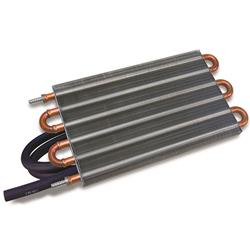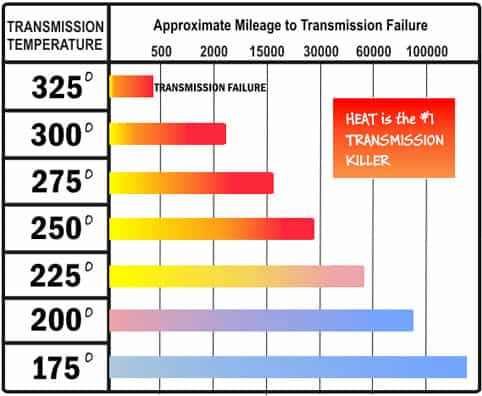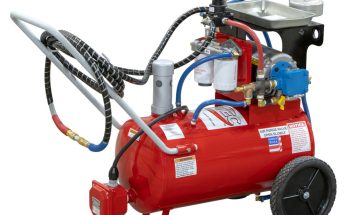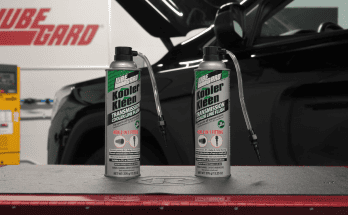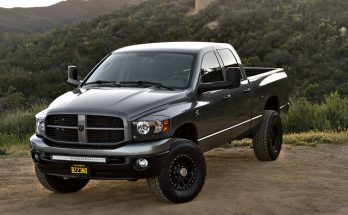Transmissions have been a source of countless car problems. These issues can be stressful and on top of that will cost you too much. The majority of transmission problems are caused by transmission overheating. The perfect transmission temperature is under 170 degrees. For every 20-degree increase in the temperature, the lifespan of your transmission is cut by half.
Heat kills automatic transmissions, especially in big powered street vehicles. The ideal transmission operating temperature is about 195 degrees F. If the vehicle transmission temperature is even slightly above this, the transmission fluid will begin to coo and form a varnish inside the transition.
A higher temperature of about 260 degrees will harden the internal transmission seals which are made of a polyacrylate material. The seals lose their elasticity leading to internal and external leaks. If subjected to 300 degrees or more, the transmission will stop working because the seals and clutches will completely burn out. The transmission fluid temperature chart below shows the expected lifespan at a given temperature.
Factors like hot climates, vehicle type, vehicle size, and heavy towing and traffic are culprits in overheating transmissions. Some people might say that’s why the radiator exists but think about this. The radiator is tasked with cooling the engine too; if it gets too overworked, it won’t work too well. An overworked radiator will have trouble cooling your system down, and you will have to replace that one as well.
If you ignore the problems, you will probably end up buying a new transmission or radiator. Instead of that, you should think about buying an external transmission cooler to help the transmission work efficiently. If you would love to know everything about transmission coolers, how they work and the different types available continue reading below.
How Do Transmission Coolers Work?
Transmissions work to keep the engine’s revolutions per minute within a suitable range. They also transmit the power to the wheels at different speeds, which can generate a lot of heat. Transmissions rely on fluid to keep them cool, but that isn’t enough in many applications.
Here is where a transmission cooler comes in. Transmission coolers help to keep the fluid cool and prevent serious damage to your vehicle. Transmissions are expensive to repair, and you can avoid this by getting a transmission cooler that is the right size for your engine.
Just like any other machine, when the weight of your vehicle increases so does the workload. Have you noticed that when you are traveling on the car alone, you can easily use less fuel than when the car is fully packed with people or heavy objects? The vehicle will even move slower, and gas mileage would decrease.
The extra weight will require the vehicle to use extra energy. Consequently, the transmission of the car will produce more heat. The heat can damage your engine system over time, and you’ll want to avoid all that cost. Some vehicles do more work than others, therefore, has different heat outputs. Transmission coolers work to reduce the heat in the transmission fluids. This also reduces the damage that may case from overheating vehicle transmission.
Types of Transmission Coolers
Automatic transmissions generate a lot of heat, even when they are operating normally. Most of the heat will get dispersed through the fluid system. The fluid system takes the fluid over the radiator which works to cool the vehicle. Even then, the transmission may still overheat. As I mentioned, overheating will cost you a lot of problems, and you should avoid at all cost.
Adding a transmission cooler to your vehicle is the most effective ways to prevent overheating. The transmission cooler is a second radiator in your vehicle but is dedicated to cooling down the transmission. For the most effective results, you will need to choose a cooler that works for your vehicle.
There are four different types of transmission coolers; tube and fin coolers, plate and fin, stacked plate, and heat sink transmission coolers. Each of which has their own set of benefits compared to the others. Keep reading for more information about the coolers.
Tube & Fin Transmission Coolers
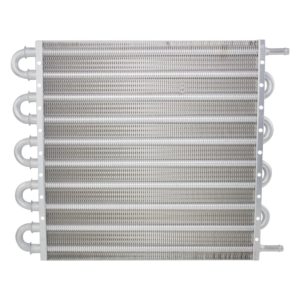
This is the least expensive and simplest type of transmission cooler. The tube-fin cooler has two principal features as the name would suggest. It has a tube that allows the transmission fluid to flow to the thin metal fins that disperse the heat and cool it. The main idea is to have air flowing over the fins which create a heat sink effect in return. Inside the cooler also lies a device called the turbulator.
The turbulator works by agitating the transmission fluids as it moves through the tubes. Agitation helps with a greater dispersion of the heat through the fins. The heat collected by the aluminum fins ultimately moves into the air that is around the coolers.
The tube-fin cooler is perfect if you have an older vehicle or your vehicle has an average to low user demand. The tube-fin coolers may not have enough power to keep the temperatures of the transmission liquids low in high-performance vehicles. The tube-fin coolers won’t cater to the high demand for such vehicles. Mounting this cooler is easy; you can place it between the grille and AC condenser of your vehicle for maximum efficiency.
Pros:
- Affordable
- Least Expensive Type of Cooler
- Easy To Install
Cons:
- Least Efficient Type of Cooler
[/joomdev-wpc-cons][/joomdev-wpc-pros-cons]
Plate & Fin Transmission Oil Coolers
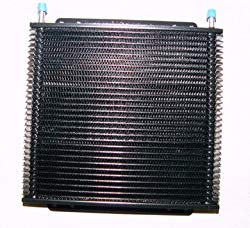
This cooler works slightly different to achieve some level of cooling efficiency. Instead of utilizing the tube like the tube-fin coolers, the plate and fin move the transmission fluid through horizontal aluminum plate series.
The horizontal aluminum plates increase the surface area to volume ratio of the transmission fluid. This means that more heat will move into the fins at a faster rate. One can say that the plate and fin coolers are pretty efficient in cooling the transmission fluids. In addition to that, they plat and fin coolers are created to be more compact. Therefore, they can easily be integrated into a full vehicle. This efficient cooling system will cost you more than the tube-fin cooler.
Mounting this cooler between the radiator and condenser will work well for your vehicle. It allows airflow but will cut the effectiveness of the cooler. A bigger plate and fin cooler works great for any vehicle.
Pros:
- More Efficient Than Tube & Fin
- Still Cost Effective
- Varies In Size
- Durable Construction
Cons:
- Can Get Expensive
- Harder To Install Larger Coolers
Stacked Plate Trans Coolers
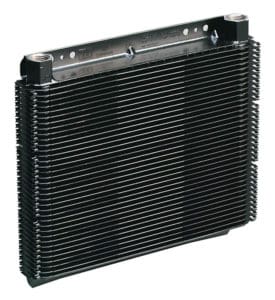
Stacked plate coolers offer a step higher when it comes to cooling efficiency. The stacked plate cooler works almost like the plate and fin cooler. The main difference between the two transmission coolers is the amount of airflow involved.
The stacked plate cooler has a design that allows easy circulation of air around the plates. This way, more heat is dispersed faster. This cooler is the top choice for racing, off-roading and towing vehicles. Some stacked plate coolers have integrated fans to increase the airflow and cater to especially high cooling demands for such vehicles.
They use a non-threaded AN fitting to make installation and removal into the vehicle easy. This cooler will not work efficiently when mounted between the condenser and radiator. It causes the cooler to be inefficient. Mounting it in front of the cooler, however, will cause more efficiency and airflow.
Stacked Plate vs. Tube-Fin Transmission Coolers
Most people wonder how effective the stacked plate is compared to the common tube-fin coolers. The stacked plate cooler will cool the transmission liquid three times faster than the tube-fin coolers.
Pros:
- Most Efficient Trans Cooler
- Larger Cooling Surface
- Very Efficient
- Durable Construction
Cons:
- Most Expensive Type of Cooler
- Harder To Install Larger Coolers
Heat Sink Transmission Coolers
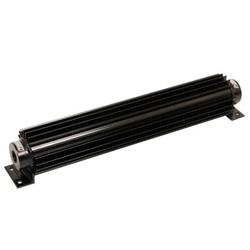
Heat sink transmission coolers are not the most common type of transmission cooler, but are still used, especially on older vehicles. These coolers utilize a unique finned aluminum design that disperses heat throughout the body of the cooler without the use of incoming air, unlike other trans coolers.
The one or dual pass internal fluid passages within heat sink transmission coolers is a lot larger than other coolers, which allows the fluid to stay in the cooler longer to cool.
Because of their design, heat sink transmission coolers are used in remote locations, such as a frame rail close to the transmission. While this may be convenient for installation, it can make it hard for the cooler to be as effective as other types of transmission coolers depending on airflow and heat dispersion.
Pros:
- Easy To Mount In Tight Areas
- Does Not Rely On Airflow
- Strong Design
- Lower Cost
Cons:
- Not As Effective As Other Coolers
How to Choose The Right Transmission Cooler
Installing the cooler is like taking an extra precaution to avoid overheating the transmission and replacing it in the long run. It is common to see transmission coolers into vehicles because they produce a lot of heat in the transmission. The first thing you should consider is the type of work your vehicle does. If you have a tow vehicle, you should get to know how much the car weighs first and the average weight you carry when you tow other vehicles.
Basically, if you are trying to get a cooler, you should know the weight of your vehicle. Matching the gross weight of your vehicle to the transmission cooler is important. It allows you to add a cooler that won’t interfere with the vehicle operation.
Another thing you have to consider is the terrain of travel. Are you driving your vehicle or towing other vehicles in an area with stop and go traffic, is the terrain hilly or are you driving across a long highway?
Strenuous hilly and rough terrains will need a lot of power from your vehicle, and that can generate unprecedented amounts of heat. This heat will damage the transmission system in just a short period. If so, you should consider whether the transmission cooler you are getting will be able to cool transmission down.
Here are other things you should consider
Copper vs. Aluminum
Arguably, the best heat exchange construction is meant to be the same for both metals. The aluminum exchangers should be as efficient and the copper and brass when it comes to thermal efficiency. In the case of the transmission cooler, the aluminum exchangers have a notably lighter efficiency rate.
On top of that, aluminum coolers are very costly because they are more difficult to manufacture. The black paint on the metal also acts as a barrier instead of promoting the fast transfer of heat to the air around the cooler. Good aluminum fins should have a thin coat of paint and be anodized to work efficiently. Baked, heat exchange paint works well for the aluminum fillers.
Trans Cooler Mounting
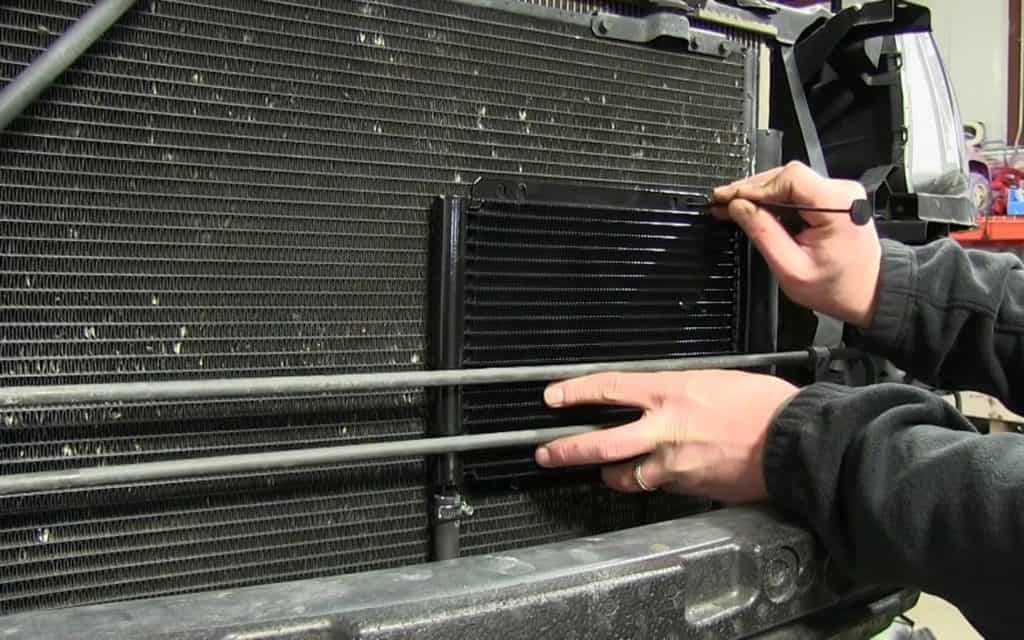
Transmission coolers should be mounted in an area of the vehicle that gets ample air flow. The most common area to mount a trans cooler is typically in front of the air conditioning condenser or radiator.
This allows both incoming air and air from the cooling fans to cool the cooler down effectively.
Another factor to consider when installing a transmission cooler is how you plan to route the external fluid lines. Since the factory transmission cooler is located in the radiator, it is usually easy to run the new transmission cooler lines to the cooler mounted in front of the condenser or radiator.
Selecting Transmission Cooler Size
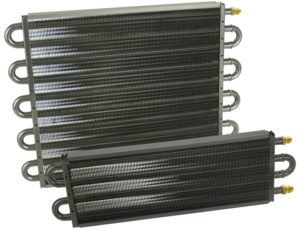
If you are running a high-performance vehicle, you need a transmission cooler. A vehicle that is constantly subjected to rough terrains, heavy loads and towing requires a large transmission cooler. Most transmission cooler manufacturers will create them in different sizes because high powered vehicles come in different sized and work differently. Coolers can be wide, narrow, large or small and installed depending on your transmission power and vehicle size.
External Transmission Cooler Vs Radiator
When purchasing and installing a transmission fluid cooler, it is important to factor in running a stand alone transmission cooler or utilizing the factory radiator.
Most external transmission cooler vs radiator or whether it is safe to bypass the radiator transmission cooler or not debates are based on how the vehicle is used and your climate.
If you have a weekend hotrod, it would be safe to run the external cooler on its own to keep trans fluid temps low. On the other side of the coin, if you have a normal daily driven vehicle that sees all types of weather, it is typically recommended to use a transmission cooler in series with the factory radiator trans cooler.
This allows the transmission cooling system to keep your vehicle within the ideal transmission temperature between 180 – 200 degrees.
Transmission Cooler Type FAQs
The best type of transmission cooler is a stacked plate style cooler. Stacked plate transmission cooler are the most efficient and provide ample cooling in most applications.
As long as your transmission cooler has enough air flow it will cool transmission temps, but stacked plate coolers perform the best.
The 4 types of transmission coolers are:
- Stacked plate
- Plate & Fin
- Tube & Fin
- Heatsink
Yes, heatsink transmission coolers work. Based on their large-body design, they do a good job at dissipating heat, but they work better in some applications better than others.
Due to their size, heatsink transmission coolers are best used on smaller vehicles or along the vehicles frame rail.
Like with any transmission cooler, heatsink transmission cooler do well with enough airflow.
Conclusion
Keeping the fluid temperatures under control is essential if you want the vehicle to keep working without issues. This should be especially important if you operate high powered street vehicles or you are always on the road. Installing a large external cooler will take up some of the transmission heat and keep the transmitter working at a cooler temperature. This ensures that your vehicle doesn’t break down or lose any viscosity.
The transmission cooler you get will depend on your vehicle and also how much you are willing to spend. Old vehicles won’t need much investment on the coolers. However, if you are driving a high powered vehicle, you should get the type of transmission cooler that will work the most efficiently, even if it costs you a lot.

